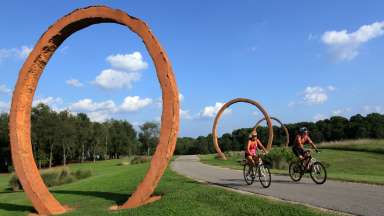Jump To:
Pedestrian Safety Tips
- Look for cars and bicyclists in all directions—including those turning left or right—before crossing the street; never assume a driver will stop.
- Be careful crossing multiple lanes of traffic. Make sure each lane of traffic is clear before you cross.
- Enhance your visibility at night. Walk in well-lit areas, carry a flashlight, or wear something reflective, such as stickers or armbands, to be more visible.
- Avoid distraction. More and more we see people texting or talking on cell phones when crossing streets; this diminishes the ability of your two key senses—hearing and seeing—that are used to detect and avoid cars. So particularly when crossing streets, put down the phone for a few seconds.
- Be predictable to drivers and follow the rules of the road—obey signs and signals.
- Obey all pedestrian traffic signals.
- Watch for cars backing up in parking lots; brake lights can mean that a car is about to back up.
- Cross the street where you have the best view of traffic. At bus stops, cross behind the bus or at the nearest crosswalk.
- Always walk on the sidewalk; if there is no sidewalk, walk facing traffic and as far from the roadway as you can.
For more pedestrian safety tips, visit the Pedestrian and Bicycle Information Center.
Bicyclist Safety Tips
- Wear a helmet. It could save your life. However, helmets are fallible. Do not be fooled into a false sense of security. Riding as safely as possible is still very important.
- Use a light and reflectors when bicycling at night and be as visible as possible.
- Ride in the direction of traffic. Drivers may not be looking for you if you are riding the wrong way.
- Obey all signs and signals. This includes stopping at stop signs and red lights.
- Use all of your senses – watch and listen for cars, particularly at intersections and driveways.
- Avoid distractions such as listening to headphones or answering phones when riding.
For more bicyclist safety tips, visit the Pedestrian and Bicycle Information Center.
